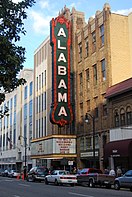|
Birmingham metropolitan area, Alabama
The Birmingham metropolitan area, sometimes known as Greater Birmingham, is a metropolitan area in north central Alabama centered on Birmingham, Alabama, United States. As of 2023[update], the federal government defines the Birmingham, AL Metropolitan Statistical Area as consisting of seven counties (Bibb, Blount, Chilton, Jefferson, St. Clair, Shelby, and Walker) centered on Birmingham.[2] The population of this metropolitan statistical area as of the 2020 census was 1,180,631, making it the 50th largest metropolitan statistical area in the United States as of that date. The seven counties in the Birmingham metropolitan statistical area are combined with the Cullman micropolitan area (Cullman County) and the Talladega–Sylacauga Micropolitan Statistical Area (Talladega County and Coosa County) to form the federally defined Birmingham–Cullman–Talladega, AL Combined Statistical Area.[2] According to the United States Census 2020 census, the combined statistical area has a population of 1,415,988. It is the 42nd largest population sub-region in the United States, and the largest population region in Alabama, constituting roughly 1/4 of the state's population. It is the largest population region in Central Alabama. The northern counties of the Birmingham metro area specifically Blount and Cullman are also part of the North Alabama region also known locally as the Tennessee Valley and are overlapped by the much larger Birmingham metropolitan area despite its proximity to the nearby Huntsville metro. Nearby counties Tuscaloosa, Etowah, and Calhoun, while not officially a part of Greater Birmingham, contribute significantly to the region's economy. The Birmingham media market covers these counties as well. According to the List of metropolitan areas of Alabama, Birmingham is the largest urban area and metro in Alabama. Birmingham is part of the Piedmont Atlantic Megaregion containing an estimated 19 million people, while many residents also consider themselves part of the Deep South. It is classified as Southeast by the U.S. Census and also falls in the geographic area of the Upland South due to its location at the southern terminus of the Appalachian foothills. The entire MSA and CSA are within the congressional Appalachian Regional Commission's definition of Appalachia. CountiesCounties marked with * are officially part of the Birmingham–Cullman–Talladega, AL Combined Statistical Area
Cities
Anchor cityPrincipal citiesCities marked with * are officially part of the Birmingham–Cullman–Talladega, AL Combined Statistical Area Suburbs with at least 10,000 inhabitants as of the 2020 census
DemographicsAccording to the 2019 ACS 1-Year Estimates Data Profiles, there were 1,090,435 people living in the Birmingham–Hoover, AL Metropolitan Area. The racial makeup of the area was 65.8% White, 31.6% African American, 1.9% Asian, 0.9% Native American, 0.1% Pacific Islander, 1.6% from other races, and 1.6% from two or more races. 4.5% of the population were Hispanic of any race.[4] EconomyThe economy of Greater Birmingham is the most diversified of any metropolitan area in Alabama. Many of the region's major employers are located in Birmingham and Jefferson County. The economy of Birmingham ranges from service industries such as banking and finance to health-related technological research and heavy industry. The University of Alabama at Birmingham (UAB) is Alabama's largest employer as well as the area's largest, with some 20,000 employees. The area is world headquarters for Regions Financial, and Books-A-Million, the second largest book retailer in the United States. Major employers
RetailBirmingham is known as the shopping destination in the state of Alabama and a primary shopping hub of the Piedmont Atlantic Megaregion. It includes the major retail destination for the region, the Riverchase Galleria mall, along with several other shopping centers and malls. Major Malls & Shopping Centers
TransportationRoadGreater Birmingham is at the convergence of four major interstate highways: Interstate 65 (which connects with Mobile and Chicago); Interstate 20 (which connects with Dallas and Atlanta); Interstate 59 (which connects with New Orleans and Chattanooga); and Interstate 22 (which connects with Memphis). Interstate 459, completed in 1984, forms a southern bypass around Birmingham. It runs through portions of Bessemer, Vestavia Hills, and Trussville, and forms a main route through the primary city of Hoover. Interstate 422, the Birmingham Northern Bypass is planned to run from the current I-20/59/459 interchange near Bessemer to Interstate 59 and US Route 11 near Argo. It is planned to be completed by 2048. Four U.S. highways, US-31, US-11, US-78, and US-280, run through Greater Birmingham. US-31 parallels Interstate 65 for its entire route, including Greater Birmingham. US-280 runs southeast of the city, connecting it with Auburn and Auburn University. The corridor through suburban Birmingham is notorious for its severe congestion as it carries about 200% of its traffic capacity. US-31 and 280 merge in Homewood to form the Elton B. Stephens Expressway known locally as the Red Mountain Expressway. This expressway goes through a geologic cut through Red Mountain, connecting downtown Birmingham to its southern suburbs. US-78 parallels Interstate 22 to the northwest of Birmingham, and Interstate 20 to the east. US-11 parallels Interstate 59 for its entire route. All four of these highways meet in downtown Birmingham. Major highways
Mass transitBirmingham received $87 million from the US Congress to help fund a regional transportation system. The city's new $30 million, three-block intermodal station brings Amtrak, Greyhound, the Birmingham-Jefferson County Transit Authority and automotive transportation together in one place. AirGreater Birmingham is served by Birmingham-Shuttlesworth International Airport with American Airlines, American Eagle, Southwest, United, and Delta providing service to more than 40 cities. Established in 1931, BHM has been governed by the Birmingham Airport Authority since its establishment in 1986. In 2008, the airport was renamed Birmingham-Shuttlesworth International Airport in honor of late Birmingham civil rights activist Rev. Fred Shuttlesworth. EducationMajor Colleges & Universities
Natural features
Rivers
See also
References
External links |
||||||||||||||||||||||||||||||||||||||||||||||||||||||||||||||||||||||||||||||||||||||||||||||||||||||||||||||||||||||||||||||||||||||||||||||||||||||||||||||||
Portal di Ensiklopedia Dunia












